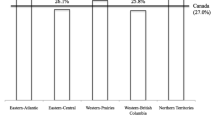Abstract
This article seeks to determine the proportion of pregnancies that are unintended among poor women in New York City, compare the New York City rate to national data, and examine factors associated with unintended pregnancy in this population. Pregnancy testing data collected between June 1, 1998, and June 1, 2001, from field sites operated by the Office of Family Health, New York City Department of Health and Mental Hygiene were analyzed. Pregnancy planning (intended vs. unintended) was examined by age group, race/ethnicity, marital status, frequency of contraceptive use, number of previous pregnancies, drug and alcohol use, and smoking. Odds ratios were calculated to determine if pregnancies were more likely to be unintended among women with certain characteristics. Logistic regression was used to examine independent risk factors for unintended pregnancy. Of the 20,518 women who had a pregnancy test during the study period, 9,406 (45.8%) were pregnant. Of the pregnancies, 82% were unintended. Marital status was the strongest predictor of unintended pregnancy, increasing the risk 2.5-fold for unmarried women. Adolescents and those who drank alcohol were also at increased risk of unintended pregnancy. The extremely high percentage of pregnancies that were unintended among the study population suggests that national unintended pregnancy rates are not representative of what occurs among low-income women in an urban setting. Unintended pregnancy interventions should be tailored for the urban poor and target unmarried, young women.
Similar content being viewed by others
References
Cartwirght A. Unintended pregnancies that lead to babies. Soc Sci Med. 1988;27:249–254.
Brown SS, Eisenberg L, eds. The Best Intentions: Unintended Pregnancy and the Well-Being of Children and Families. Washington, DC: National Academy Press; 1995.
Maynard RA. Kids Having Kids: a Robin Hood Foundation Special Report on the Costs of Adolescent Childbearing; 1996.
Henshaw S. Unintended pregnancy in the United States. Fam Plann Perspect. 1998; 30:24–29.
Beck LF, Morrow B, Lipscomb LE, et al. Prevalence of select maternal behaviors and experiences, Pregnancy Risk Assessment Monitoring System (PRAMS). MMWR CDC Surveill Summ. 2002;51(SS02):1–26.
Ventura SJ, Mosher WD, Curtin SC, Abma JC, Henshaw S. Trends in pregnancies and pregnancy rates by outcome: Estimates for the United States, 1976–96. National Center for Health Statistics. Vital Health Stat. 2000;21:1–47.
Mbizvo MT, Bonduelle MN, Chadzuka S, Lindmark G, Nystrom L. Unplanned pregnancies in Harare: What are the social and sexual determinants? Soc Sci Med. 1997;45:937–942.
Peacock NR, Kelley MA, Carpenter C, et al. Pregnancy discovery and acceptance among low-income primiparous women: a multicultural exploration. Matern Child Health J. 2001;5:109–118.
Sable MR, Libbus MK. Pregnancy intention and pregnancy happiness: Are they different? Matern Child Health J. 2000;4:191–196.
Cloud SJ, Baker KM, DePersio SR, DeCoster EC, Lorenz RR. Alcohol consumption among Oklahoma women: before and during pregnancy. The PRAMS working group. Pregnancy Risk Assessment Monitoring System. J Okla State Med Assoc. 1997;90:10–17.
Petersen R, Gazmararian JA, Anderson Clark K, Green DC. How contraceptive use patterns differ by pregnancy intention: implications for counseling. Womens Health Issues 2001;11:427–435.
United States census profile. Available at: http://censtats.census.gov/data/US/01000.pdf. Accessed March 2004.
New York State census profile. Available at: http://censtats.census.gov/data/NY/04036.pdf.
New York City, New York, census profile. Available at: http://censtats.census.gov/data/NY/1603651000.pdf. Accessed March 2004.
Los Angeles, California, census profile. Available at: http://censtats.census.gov/data/CA/1600644000.pdf. Accessed March 2004.
Chicago, Illinois, census profile. Available at: http://censtats.census.gov/data/IL/1601714000.pdf. Accessed March 2004.
Author information
Authors and Affiliations
Corresponding author
Rights and permissions
About this article
Cite this article
Besculides, M., Laraque, F. Unintended pregnancy among the urban poor. J Urban Health 81, 340–348 (2004). https://doi.org/10.1093/jurban/jth122
Issue Date:
DOI: https://doi.org/10.1093/jurban/jth122




